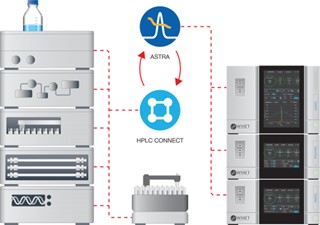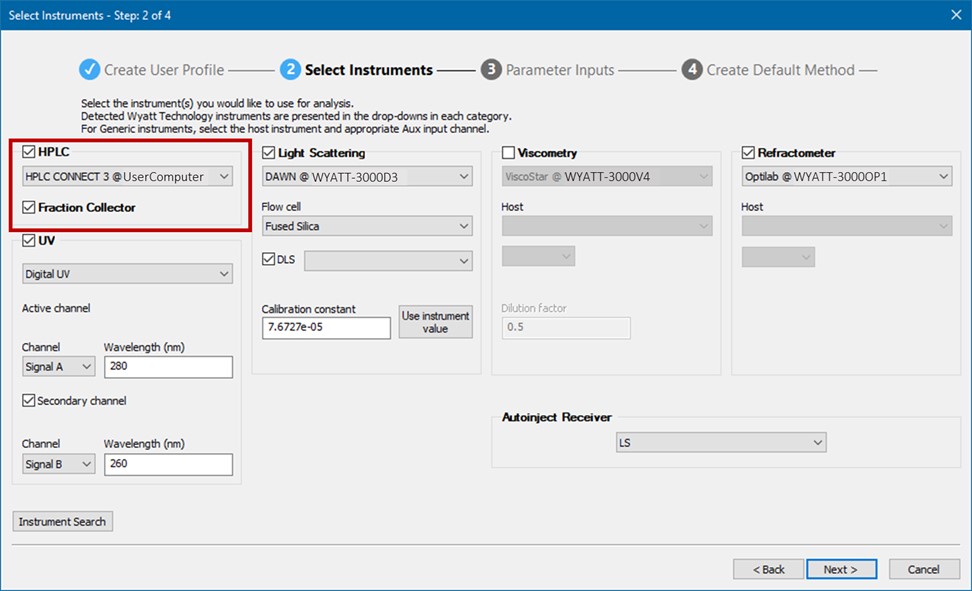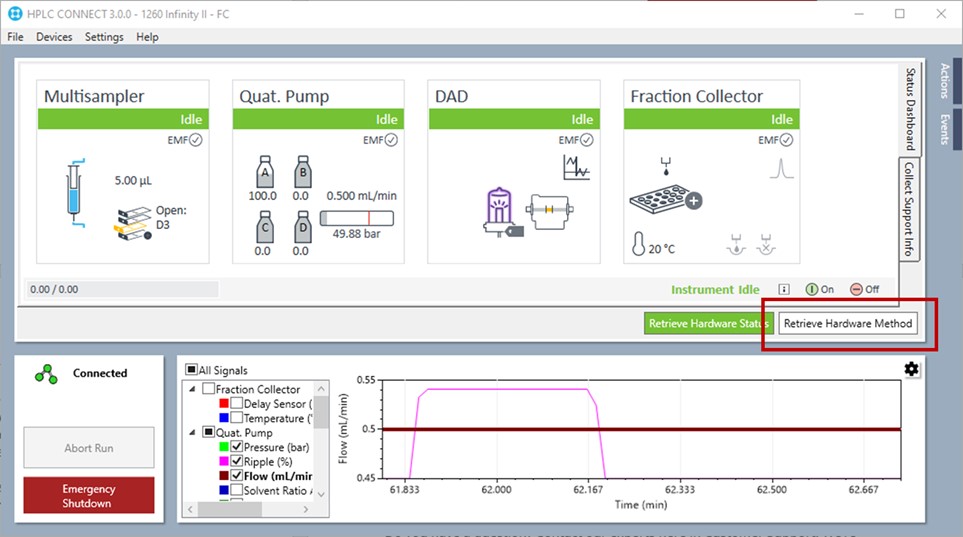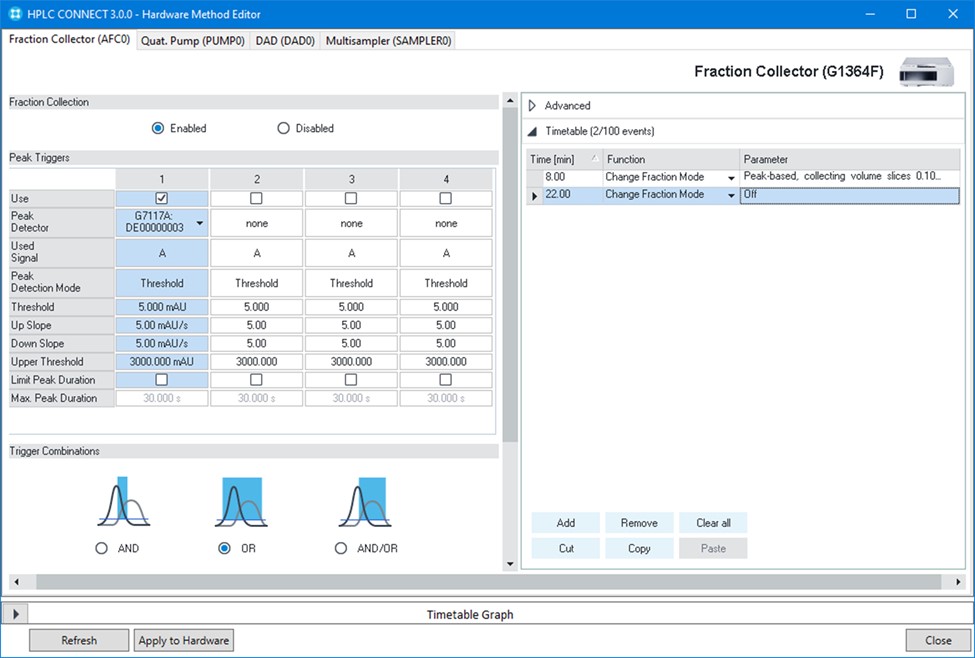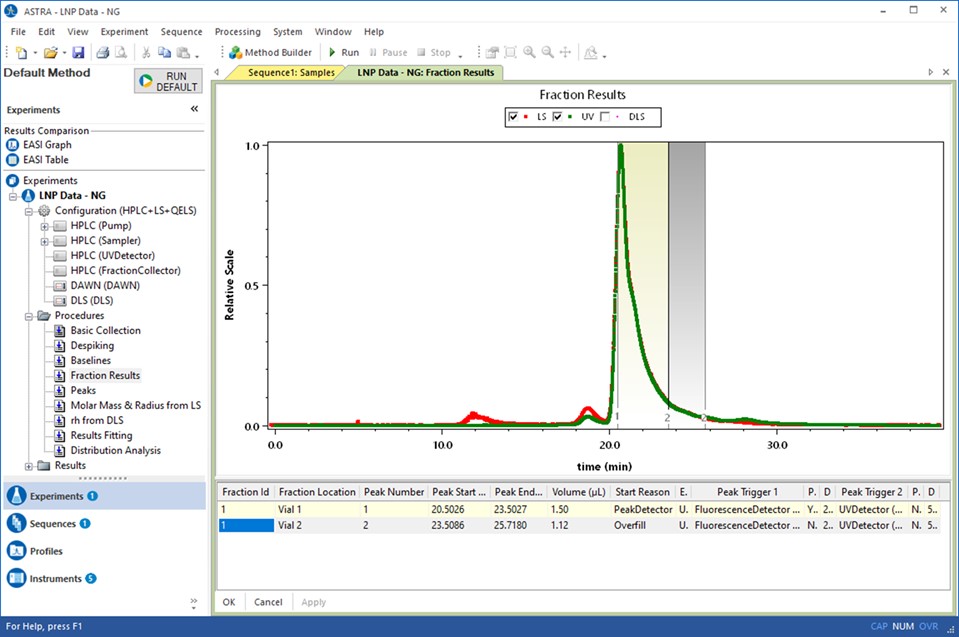How do I set up a fraction collector method with HPLC CONNECT™ 3 and ASTRA™?

Introduction
PLC CONNECT 3 further refines our digital synchronization between your HPLC, Wyatt detectors, and ASTRA by completely re-designing the HPLC Dashboard to allow a more familiar and directly accessible native HPLC instrument control framework. Among the various benefits of this new workflow, you are now able to create fraction collector methods within HPLC CONNECT™.
Coupling online detectors, such as multi-angle light scattering (MALS), dynamic light scattering (DLS), intrinsic viscosity (IV), and refractive index (RI) to your upstream chromatography separation is incredibly convenient for comprehensive characterization in a single, continuous flow path. Despite Wyatt Technology™ detectors being easily installed downstream of most HPLC, FPLC, or UHPLC instrumentation, you often need a third-party software application for controlling your LC system—this means running two sequence tables (HPLC and ASTRA) in parallel. HPLC CONNECT allows ASTRA to control your HPLC or UHPLC, which means you get a single integrated solution and many benefits—from minimizing user error to saving you both time and money.
Previous versions of HPLC CONNECT required another utility to access and edit the fraction collector hardware method. And even if you uploaded a method to the hardware, the results from the fraction collector method would not be available in ASTRA. The guesswork for correlating peaks to fraction volumes is eliminated with the latest software, everything works much more seamlessly!
You can find more information on our website about the other benefits of HPLC CONNECT, using fraction collectors with FFF-MALS, and the benefits of utilizing upstream detectors to ensure purity and identity when coupling to fraction collectors.
Configuring a Fraction Collector Method in ASTRA
Comprehensive instructions for creating an ASTRA method can be found in the ASTRA and HPLC CONNECT User’s Guides found on the Support Center. Creating methods in ASTRA is easier than ever with the Method Builder Wizard feature. When HPLC CONNECT is selected in step 2 of the Method Builder Wizard workflow, you can now choose to include the fraction collector as part of your system, which is indicated in the image to the right.
Select your HPLC, Wyatt detectors, and even third-party detectors such as a UV detector to build your ASTRA method and capture other information like default sample properties and record-keeping information. The Method Builder Wizard will generate a suitable method, and with the fraction collector option checked, will provide a method for both data collection and fraction collection results. Now all you need to do is configure your fraction collector method and run your sequence!
Creating a Fraction Collector Method with HPLC CONNECT
Editing the fraction collector method can be done directly in the HPLC CONNECT dashboard by retrieving the hardware method. The HPLC CONNECT dashboard allows direct control and access to the HPLC components, including your pump, autosampler, column compartment, HPLC detectors, and fraction collector. Because HPLC CONNECT is built on the native instrument control framework for your HPLC, the appearance will be familiar to that of your third-party LC software.
Once retrieved, you can build your fraction collector timetable for time-based collections or utilize your UV and/or FLD for peak-trigger based collections. A time-based collection is ideal when collecting fractions based on an existing MALS or RI data trace, where you know when you want to collect fractions. A peak trigger can be used to determine a specific UV threshold for which fractions will be collected, for example, when the UV signal exceeds 5 mAU. You could also use slope, as well as both threshold and slope as peak triggers—you can even set trigger combinations if using multiple triggers (i.e., UV and FLD). An example fraction collector method is shown to the right.
Apply to Hardware
Once you have created or modified the method to your liking, you can select the “Apply to Hardware” button at the lower left of the method window to apply your method to the HPLC hardware. Note that this will apply all method settings, including those under the pump and sampler tabs. But the convenience of HPLC CONNECT is that everything is in one place. With your fraction collector method configured, you are ready to run your ASTRA sequence as you have always done, now with your HPLC CONNECT integrated method.
Viewing Fraction Collector Results in ASTRA
ASTRA 8.2 adds a procedure that displays fraction collector results. After running your method, ASTRA will generate an experiment file that has all of your HPLC settings and method information stored in the configuration for record keeping. Additionally, you will see a new node under “Procedures” that will display your fraction collector results overlaid on your chromatogram. An example is shown to the right. A graph showing the detector data, in this case UV, is highlighted and the corresponding information is provided in a table beneath the graph. The tabulated information includes the vials where fractions were collected, the volume collected, and the reason for collection, such as a UV or FLD peak trigger.
Using a fraction collector successfully with chromatography is one way to expand your analyte characterization capabilities, especially when using batch techniques like microscopy or mass spec, which may be more challenging to incorporate in a single flow path like traditional SEC-MALS with UV, RI, IV, FLD, and other inline-compatible detectors. And with the latest HPLC CONNECT and ASTRA improvements, fraction collector operation and collection analysis have never been more convenient.
Conclusion
Chromatography is naturally suited for inline characterization with a variety of detectors and has numerous advantages when paired with a fraction collector. HPLC CONNECT 3 and ASTRA 8.2 add brand-new fraction collector features including fraction collector method customization with HPLC CONNECT and fraction collection results in ASTRA.
Do you have a question? Contact our experts here in Customer Support. We’re happy to help! Call +1 (805) 681-9009 option 4.

